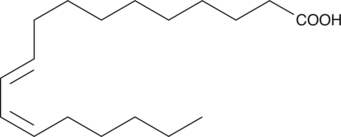Chemicals
Showing 3001–3150 of 41137 results
-
10-Nitrolinoleate is the product of nitration of linoleate by NO-derived reactive species.{25769,11912} Other nitrolinoleates detected in human plasma and urine include 9-, 12-, and 13-nitrolinoleate.{25770} Nitrolinoleates activate peroxisome proliferator-activated receptor γ (PPARγ; Ki = 133 nM), inducing CD36 expression in macrophages, adipocyte differentiation, and glucose uptake.{14255,13284} Nitrolinoleates can also be metabolized by smooth muscle cells to produce nitrite derivatives which in turn form NO, leading to increased cGMP production and smooth muscle relaxation.{11912,13287} Through the same mechanism, nitrolinoleate-derived NO suppresses leukocyte adhesion, in part through nitrosation of CD40.{25768} Alteratively, nitrolinoleates can act independently of NO/cGMP and PPARγ signaling to suppress neutrophil and macrophage functions.{25769,25770,14473}
Brand:CaymanSKU:10037 - 1 mgAvailable on backorder
10-Nitrolinoleate is the product of nitration of linoleate by NO-derived reactive species.{25769,11912} Other nitrolinoleates detected in human plasma and urine include 9-, 12-, and 13-nitrolinoleate.{25770} Nitrolinoleates activate peroxisome proliferator-activated receptor γ (PPARγ; Ki = 133 nM), inducing CD36 expression in macrophages, adipocyte differentiation, and glucose uptake.{14255,13284} Nitrolinoleates can also be metabolized by smooth muscle cells to produce nitrite derivatives which in turn form NO, leading to increased cGMP production and smooth muscle relaxation.{11912,13287} Through the same mechanism, nitrolinoleate-derived NO suppresses leukocyte adhesion, in part through nitrosation of CD40.{25768} Alteratively, nitrolinoleates can act independently of NO/cGMP and PPARγ signaling to suppress neutrophil and macrophage functions.{25769,25770,14473}
Brand:CaymanSKU:10037 - 100 µgAvailable on backorder
10-Nitrolinoleate is the product of nitration of linoleate by NO-derived reactive species.{25769,11912} Other nitrolinoleates detected in human plasma and urine include 9-, 12-, and 13-nitrolinoleate.{25770} Nitrolinoleates activate peroxisome proliferator-activated receptor γ (PPARγ; Ki = 133 nM), inducing CD36 expression in macrophages, adipocyte differentiation, and glucose uptake.{14255,13284} Nitrolinoleates can also be metabolized by smooth muscle cells to produce nitrite derivatives which in turn form NO, leading to increased cGMP production and smooth muscle relaxation.{11912,13287} Through the same mechanism, nitrolinoleate-derived NO suppresses leukocyte adhesion, in part through nitrosation of CD40.{25768} Alteratively, nitrolinoleates can act independently of NO/cGMP and PPARγ signaling to suppress neutrophil and macrophage functions.{25769,25770,14473}
Brand:CaymanSKU:10037 - 500 µgAvailable on backorder
Nitrated unsaturated fatty acids, such as 10- and 12-nitrolinoleate (LNO2; Item No. 10037), cholesteryl nitrolinoleate, and nitrohydroxylinoleate, represent a new class of endogenous lipid-derived signalling molecules. LNO2 isomers serve as potent endogenous ligands for PPARγ and can also decompose or be metabolized to release nitric oxide.{11912,13284,13287,13288} 10-Nitrooleate is one of two regioisomers of nitrooleate, the other being 9-nitrooleate (Item No. 10008042) (OA-NO2; used for the mixture of isomers), which are formed by nitration of oleic acid in approximately equal proportions in vivo.{14255} Peroxynitrite, acidified nitrite, and myeloperoxidase in the presence of H2O2 and nitrite, all mediate the nitration of oleic acid. OA-NO2 is found in human plasma as the free acid and esterified in phospholipids at concentrations of 619 ± 52 nM and 302 ± 369 nM, respectively. OA-NO2 activates PPARγ approximately 7-fold at a concentration of 1 µM and effectively promotes differentiation 3T3-L1 preadipocytes to adipocytes at 3 µM.{14255}
Brand:CaymanSKU:10008043 - 1 mgAvailable on backorder
Nitrated unsaturated fatty acids, such as 10- and 12-nitrolinoleate (LNO2; Item No. 10037), cholesteryl nitrolinoleate, and nitrohydroxylinoleate, represent a new class of endogenous lipid-derived signalling molecules. LNO2 isomers serve as potent endogenous ligands for PPARγ and can also decompose or be metabolized to release nitric oxide.{11912,13284,13287,13288} 10-Nitrooleate is one of two regioisomers of nitrooleate, the other being 9-nitrooleate (Item No. 10008042) (OA-NO2; used for the mixture of isomers), which are formed by nitration of oleic acid in approximately equal proportions in vivo.{14255} Peroxynitrite, acidified nitrite, and myeloperoxidase in the presence of H2O2 and nitrite, all mediate the nitration of oleic acid. OA-NO2 is found in human plasma as the free acid and esterified in phospholipids at concentrations of 619 ± 52 nM and 302 ± 369 nM, respectively. OA-NO2 activates PPARγ approximately 7-fold at a concentration of 1 µM and effectively promotes differentiation 3T3-L1 preadipocytes to adipocytes at 3 µM.{14255}
Brand:CaymanSKU:10008043 - 100 µgAvailable on backorder
Nitrated unsaturated fatty acids, such as 10- and 12-nitrolinoleate (LNO2; Item No. 10037), cholesteryl nitrolinoleate, and nitrohydroxylinoleate, represent a new class of endogenous lipid-derived signalling molecules. LNO2 isomers serve as potent endogenous ligands for PPARγ and can also decompose or be metabolized to release nitric oxide.{11912,13284,13287,13288} 10-Nitrooleate is one of two regioisomers of nitrooleate, the other being 9-nitrooleate (Item No. 10008042) (OA-NO2; used for the mixture of isomers), which are formed by nitration of oleic acid in approximately equal proportions in vivo.{14255} Peroxynitrite, acidified nitrite, and myeloperoxidase in the presence of H2O2 and nitrite, all mediate the nitration of oleic acid. OA-NO2 is found in human plasma as the free acid and esterified in phospholipids at concentrations of 619 ± 52 nM and 302 ± 369 nM, respectively. OA-NO2 activates PPARγ approximately 7-fold at a concentration of 1 µM and effectively promotes differentiation 3T3-L1 preadipocytes to adipocytes at 3 µM.{14255}
Brand:CaymanSKU:10008043 - 50 µgAvailable on backorder
Nitrated unsaturated fatty acids, such as 10- and 12-nitrolinoleate (LNO2; Item No. 10037), cholesteryl nitrolinoleate, and nitrohydroxylinoleate, represent a new class of endogenous lipid-derived signalling molecules. LNO2 isomers serve as potent endogenous ligands for PPARγ and can also decompose or be metabolized to release nitric oxide.{11912,13284,13287,13288} 10-Nitrooleate is one of two regioisomers of nitrooleate, the other being 9-nitrooleate (Item No. 10008042) (OA-NO2; used for the mixture of isomers), which are formed by nitration of oleic acid in approximately equal proportions in vivo.{14255} Peroxynitrite, acidified nitrite, and myeloperoxidase in the presence of H2O2 and nitrite, all mediate the nitration of oleic acid. OA-NO2 is found in human plasma as the free acid and esterified in phospholipids at concentrations of 619 ± 52 nM and 302 ± 369 nM, respectively. OA-NO2 activates PPARγ approximately 7-fold at a concentration of 1 µM and effectively promotes differentiation 3T3-L1 preadipocytes to adipocytes at 3 µM.{14255}
Brand:CaymanSKU:10008043 - 500 µgAvailable on backorder
10-Norparvulenone is a fungal metabolite originally isolated from Microsphaeropsis.{49592} It decreases viral sialidase activity in, and increases survival of, MDCK cells infected with the mouse-adapted influenza virus A/PR/8/34 when used at a concentration of 1 µg/ml.
Brand:CaymanSKU:29452 - 1 mgAvailable on backorder
Brand:CaymanSKU:21672 -Out of stock
Brand:CaymanSKU:21672 -Out of stock
10-PAHSA is a newly identified endogenous lipid that belongs to a collection of branched fatty acid esters of hydroxy fatty acids (FAHFAs). It is a FAHFA in which palmitic acid (Item No. 10006627) is esterified to 10-hydroxy stearic acid. Among the FAHFA family members, PAHSAs are the most abundant in the adipose tissue of glucose tolerant AG4OX mice, which overexpress the Glut4 glucose transporter specifically in adipose tissue.{27644} As other FAHFAs improve glucose tolerance, stimulate insulin secretion, and have anti-inflammatory effects, 10-PAHSA may be a bioactive lipid with roles in metabolic syndrome and inflammation.{27644}
Brand:CaymanSKU:19973 -Available on backorder
10-PAHSA is a newly identified endogenous lipid that belongs to a collection of branched fatty acid esters of hydroxy fatty acids (FAHFAs). It is a FAHFA in which palmitic acid (Item No. 10006627) is esterified to 10-hydroxy stearic acid. Among the FAHFA family members, PAHSAs are the most abundant in the adipose tissue of glucose tolerant AG4OX mice, which overexpress the Glut4 glucose transporter specifically in adipose tissue.{27644} As other FAHFAs improve glucose tolerance, stimulate insulin secretion, and have anti-inflammatory effects, 10-PAHSA may be a bioactive lipid with roles in metabolic syndrome and inflammation.{27644}
Brand:CaymanSKU:19973 -Available on backorder
10-PAHSA is a newly identified endogenous lipid that belongs to a collection of branched fatty acid esters of hydroxy fatty acids (FAHFAs). It is a FAHFA in which palmitic acid (Item No. 10006627) is esterified to 10-hydroxy stearic acid. Among the FAHFA family members, PAHSAs are the most abundant in the adipose tissue of glucose tolerant AG4OX mice, which overexpress the Glut4 glucose transporter specifically in adipose tissue.{27644} As other FAHFAs improve glucose tolerance, stimulate insulin secretion, and have anti-inflammatory effects, 10-PAHSA may be a bioactive lipid with roles in metabolic syndrome and inflammation.{27644}
Brand:CaymanSKU:19973 -Available on backorder
10-Pyrene-PC is a substrate for all PLA2s with the exception of cPLA2 and PAF-AH.{5681} Upon phospholipid hydrolysis, 10-pyrenyldecanoic acid is produced from 10-pyrene-PC. The monomeric 10-pyrenyldecanoic acid exhibits fluorescence (excitation 345 nm, emission 395 nm), allowing quantitation of phospholipase activity.{3839}
Brand:CaymanSKU:62245 - 1 mgAvailable on backorder
10-Pyrene-PC is a substrate for all PLA2s with the exception of cPLA2 and PAF-AH.{5681} Upon phospholipid hydrolysis, 10-pyrenyldecanoic acid is produced from 10-pyrene-PC. The monomeric 10-pyrenyldecanoic acid exhibits fluorescence (excitation 345 nm, emission 395 nm), allowing quantitation of phospholipase activity.{3839}
Brand:CaymanSKU:62245 - 10 mgAvailable on backorder
10-Pyrene-PC is a substrate for all PLA2s with the exception of cPLA2 and PAF-AH.{5681} Upon phospholipid hydrolysis, 10-pyrenyldecanoic acid is produced from 10-pyrene-PC. The monomeric 10-pyrenyldecanoic acid exhibits fluorescence (excitation 345 nm, emission 395 nm), allowing quantitation of phospholipase activity.{3839}
Brand:CaymanSKU:62245 - 5 mgAvailable on backorder
Heteroatom-substituted fatty acids have been observed to modulate the extension and desaturating of fatty acids, and to influence their distribution within phospholipids pools.{13246,13251} 10-Thiastearic acid inhibits desaturation of radiolabeled stearate to oleate in rat hepatocytes and hepatoma cells by more than 80% at a concentration of 25 µM.{13250} This activity is associated with a hypolipidemic effect, making this 10-thiastearic acid a useful tool for evaluating new anti-obesity therapeutics.
Brand:CaymanSKU:10007417 - 10 mgAvailable on backorder
Heteroatom-substituted fatty acids have been observed to modulate the extension and desaturating of fatty acids, and to influence their distribution within phospholipids pools.{13246,13251} 10-Thiastearic acid inhibits desaturation of radiolabeled stearate to oleate in rat hepatocytes and hepatoma cells by more than 80% at a concentration of 25 µM.{13250} This activity is associated with a hypolipidemic effect, making this 10-thiastearic acid a useful tool for evaluating new anti-obesity therapeutics.
Brand:CaymanSKU:10007417 - 100 mgAvailable on backorder
Heteroatom-substituted fatty acids have been observed to modulate the extension and desaturating of fatty acids, and to influence their distribution within phospholipids pools.{13246,13251} 10-Thiastearic acid inhibits desaturation of radiolabeled stearate to oleate in rat hepatocytes and hepatoma cells by more than 80% at a concentration of 25 µM.{13250} This activity is associated with a hypolipidemic effect, making this 10-thiastearic acid a useful tool for evaluating new anti-obesity therapeutics.
Brand:CaymanSKU:10007417 - 5 mgAvailable on backorder
Heteroatom-substituted fatty acids have been observed to modulate the extension and desaturating of fatty acids, and to influence their distribution within phospholipids pools.{13246,13251} 10-Thiastearic acid inhibits desaturation of radiolabeled stearate to oleate in rat hepatocytes and hepatoma cells by more than 80% at a concentration of 25 µM.{13250} This activity is associated with a hypolipidemic effect, making this 10-thiastearic acid a useful tool for evaluating new anti-obesity therapeutics.
Brand:CaymanSKU:10007417 - 50 mgAvailable on backorder
10,11-dehydro Curvularin is a natural mycotoxin that has cytotoxic activity against select cancer cell lines.{34313,34316} It has been shown to activate the heat shock response, block TGF-β signaling, and scavenge superoxide anions.{34313,34314,34315}
Brand:CaymanSKU:21801 -Out of stock
10,11-dehydro Curvularin is a natural mycotoxin that has cytotoxic activity against select cancer cell lines.{34313,34316} It has been shown to activate the heat shock response, block TGF-β signaling, and scavenge superoxide anions.{34313,34314,34315}
Brand:CaymanSKU:21801 -Out of stock
10,11-dehydro Curvularin is a natural mycotoxin that has cytotoxic activity against select cancer cell lines.{34313,34316} It has been shown to activate the heat shock response, block TGF-β signaling, and scavenge superoxide anions.{34313,34314,34315}
Brand:CaymanSKU:21801 -Out of stock
10,11-dihydro-10-hydroxy Carbamazepinee is the active metabolite of oxcarbazepine (Item No. 17340). Oxcarbazepine is rapidly and almost completely converted to 10,11-dihydro-10-hydroxycarbamazepine, which then demonstrates anticonvulsant efficacy by modulating several ion channels and receptors.{25311,25313} 10,11-dihydro-10-hydroxy Carbamazepine is reported to inhibit both voltage-gated Na+ and Ca2+ channels, to potentiate voltage-gated K+ channels, to antagonize adenosine A1 receptors, to increase dopaminergic transmission, and to inhibit glutamate release.{25311}
Brand:CaymanSKU:-Available on backorder
10,11-dihydro-10-hydroxy Carbamazepinee is the active metabolite of oxcarbazepine (Item No. 17340). Oxcarbazepine is rapidly and almost completely converted to 10,11-dihydro-10-hydroxycarbamazepine, which then demonstrates anticonvulsant efficacy by modulating several ion channels and receptors.{25311,25313} 10,11-dihydro-10-hydroxy Carbamazepine is reported to inhibit both voltage-gated Na+ and Ca2+ channels, to potentiate voltage-gated K+ channels, to antagonize adenosine A1 receptors, to increase dopaminergic transmission, and to inhibit glutamate release.{25311}
Brand:CaymanSKU:-Available on backorder
10,11-dihydro-10-hydroxy Carbamazepinee is the active metabolite of oxcarbazepine (Item No. 17340). Oxcarbazepine is rapidly and almost completely converted to 10,11-dihydro-10-hydroxycarbamazepine, which then demonstrates anticonvulsant efficacy by modulating several ion channels and receptors.{25311,25313} 10,11-dihydro-10-hydroxy Carbamazepine is reported to inhibit both voltage-gated Na+ and Ca2+ channels, to potentiate voltage-gated K+ channels, to antagonize adenosine A1 receptors, to increase dopaminergic transmission, and to inhibit glutamate release.{25311}
Brand:CaymanSKU:-Available on backorder
10,11-dihydro-10-hydroxy Carbamazepinee is the active metabolite of oxcarbazepine (Item No. 17340). Oxcarbazepine is rapidly and almost completely converted to 10,11-dihydro-10-hydroxycarbamazepine, which then demonstrates anticonvulsant efficacy by modulating several ion channels and receptors.{25311,25313} 10,11-dihydro-10-hydroxy Carbamazepine is reported to inhibit both voltage-gated Na+ and Ca2+ channels, to potentiate voltage-gated K+ channels, to antagonize adenosine A1 receptors, to increase dopaminergic transmission, and to inhibit glutamate release.{25311}
Brand:CaymanSKU:-Available on backorder
10,13-epoxy-10,12-Octadecadienoic acid is a furan fatty acid produced by oxidation of 10(E),12(Z)-conjugated linoleic acid (Item No. 90145).{46131,46132} It upregulates the expression of PLIN2, TPD52L2, and SEC13, which are involved in the formation of lipid droplets, and downregulates a variety of genes involved in general cellular processes in Caco-2 cells.{46132} 10,13-epoxy-10,12-Octadecadienoic acid is cytotoxic to Caco-2 and HepG2 cells when used concentrations greater than or equal to 100 µM.
Brand:CaymanSKU:26767 - 1 mgAvailable on backorder
10,13-epoxy-10,12-Octadecadienoic acid is a furan fatty acid produced by oxidation of 10(E),12(Z)-conjugated linoleic acid (Item No. 90145).{46131,46132} It upregulates the expression of PLIN2, TPD52L2, and SEC13, which are involved in the formation of lipid droplets, and downregulates a variety of genes involved in general cellular processes in Caco-2 cells.{46132} 10,13-epoxy-10,12-Octadecadienoic acid is cytotoxic to Caco-2 and HepG2 cells when used concentrations greater than or equal to 100 µM.
Brand:CaymanSKU:26767 - 500 µgAvailable on backorder
10’-Desmethoxystreptonigrin is an antibiotic originally isolated from Streptomyces and a derivative of the antibiotic streptonigrin.{49160} It is active against a variety of bacteria, including S. aureus, S. faecalis, E. coli, K. pneumoniae, and P. vulgaris (MICs = 0.4, 1.6, 3.1, 3.1, and 0.4 µg/ml, respectively).{49161} 10’-Desmethoxystreptonigrin is cytotoxic to HCT116 colon and A2780 ovarian cancer cells (IC50s = 0.004 and 0.001 µg/ml, respectively), as well as HCT116 cells resistant to etoposide (Item No. 12092) and teniposide (Item No. 14425) and cisplatin-resistant A2780 cells (IC50s = 0.003, 0.001, and 0.01 µg/ml, respectively). 10’-Desmethoxystreptonigrin is also an inhibitor of p21ras farnesylation (IC50 = 21 nM).
Brand:CaymanSKU:28065 - 2.5 mgAvailable on backorder
10’-Desmethoxystreptonigrin is an antibiotic originally isolated from Streptomyces and a derivative of the antibiotic streptonigrin.{49160} It is active against a variety of bacteria, including S. aureus, S. faecalis, E. coli, K. pneumoniae, and P. vulgaris (MICs = 0.4, 1.6, 3.1, 3.1, and 0.4 µg/ml, respectively).{49161} 10’-Desmethoxystreptonigrin is cytotoxic to HCT116 colon and A2780 ovarian cancer cells (IC50s = 0.004 and 0.001 µg/ml, respectively), as well as HCT116 cells resistant to etoposide (Item No. 12092) and teniposide (Item No. 14425) and cisplatin-resistant A2780 cells (IC50s = 0.003, 0.001, and 0.01 µg/ml, respectively). 10’-Desmethoxystreptonigrin is also an inhibitor of p21ras farnesylation (IC50 = 21 nM).
Brand:CaymanSKU:28065 - 500 µgAvailable on backorder
10(E)-Pentadecenoic acid is a 15-carbon, long-chain monounsaturated fatty acid. It inhibits IFN-γ-induced production of kynurenine in THP-1 cells by 14% when used at a concentration of 20 µM.{40333} 10(E)-Pentadecenoic acid has been used in studies of alternative β-oxidation pathways.{35136,35135}
Brand:CaymanSKU:22467 -Out of stock
10(E)-Pentadecenoic acid is a 15-carbon, long-chain monounsaturated fatty acid. It inhibits IFN-γ-induced production of kynurenine in THP-1 cells by 14% when used at a concentration of 20 µM.{40333} 10(E)-Pentadecenoic acid has been used in studies of alternative β-oxidation pathways.{35136,35135}
Brand:CaymanSKU:22467 -Out of stock
10(E)-Pentadecenoic acid is a 15-carbon, long-chain monounsaturated fatty acid. It inhibits IFN-γ-induced production of kynurenine in THP-1 cells by 14% when used at a concentration of 20 µM.{40333} 10(E)-Pentadecenoic acid has been used in studies of alternative β-oxidation pathways.{35136,35135}
Brand:CaymanSKU:22467 -Out of stock
10(E)-Pentadecenoic acid is a 15-carbon, long-chain monounsaturated fatty acid. It inhibits IFN-γ-induced production of kynurenine in THP-1 cells by 14% when used at a concentration of 20 µM.{40333} 10(E)-Pentadecenoic acid has been used in studies of alternative β-oxidation pathways.{35136,35135}
Brand:CaymanSKU:22467 -Out of stock
Conjugated linoleic acid (CLA) refers to a family of 8 geometric isomers of linoleic acid in which the two double bonds are contiguous. (The predominant form of linoleic acid in nature, 18:ω6, has double bonds at 9 and 12, interrupted by a methylene carbon.) CLA is found in both meat and dairy products, but it is not found to any significant degree in plants. The predominant isomer of CLA in animal tissue is 9Z,11E; smaller amounts of 10E,12Z also occur. Various antioxidant and antitumor activities have been attributed to CLA or its downstream metabolites.{6849} Reported health benefits of dietary supplementation with CLA have been attributed variously to competitive inhibition of Δ6-desaturase and/or PPARγ activation.{6980} [Matreya, LLC. Catalog No. 1249]
Brand:CaymanSKU:90145 - 10 mgAvailable on backorder
Conjugated linoleic acid (CLA) refers to a family of 8 geometric isomers of linoleic acid in which the two double bonds are contiguous. (The predominant form of linoleic acid in nature, 18:ω6, has double bonds at 9 and 12, interrupted by a methylene carbon.) CLA is found in both meat and dairy products, but it is not found to any significant degree in plants. The predominant isomer of CLA in animal tissue is 9Z,11E; smaller amounts of 10E,12Z also occur. Various antioxidant and antitumor activities have been attributed to CLA or its downstream metabolites.{6849} Reported health benefits of dietary supplementation with CLA have been attributed variously to competitive inhibition of Δ6-desaturase and/or PPARγ activation.{6980} [Matreya, LLC. Catalog No. 1249]
Brand:CaymanSKU:90145 - 25 mgAvailable on backorder
Conjugated linoleic acid (CLA) refers to a family of 8 geometric isomers of linoleic acid in which the two double bonds are contiguous. (The predominant form of linoleic acid in nature, 18:ω6, has double bonds at 9 and 12, interrupted by a methylene carbon.) CLA is found in both meat and dairy products, but it is not found to any significant degree in plants. The predominant isomer of CLA in animal tissue is 9Z,11E; smaller amounts of 10E,12Z also occur. Various antioxidant and antitumor activities have been attributed to CLA or its downstream metabolites.{6849} Reported health benefits of dietary supplementation with CLA have been attributed variously to competitive inhibition of Δ6-desaturase and/or PPARγ activation.{6980} [Matreya, LLC. Catalog No. 1249]
Brand:CaymanSKU:90145 - 5 mgAvailable on backorder
Conjugated linoleic acid (CLA) refers to a family of 8 geometric isomers of linoleic acid in which the two double bonds are contiguous. (The predominant form of linoleic acid in nature, 18:ω6, has double bonds at 9 and 12, interrupted by a methylene carbon.) CLA is found in both meat and dairy products, but it is not found to any significant degree in plants. The predominant isomer of CLA in animal tissue is 9Z,11E; smaller amounts of 10E,12Z also occur. Various antioxidant and antitumor activities have been attributed to CLA or its downstream metabolites.{6849} Reported health benefits of dietary supplementation with CLA have been attributed variously to competitive inhibition of Δ6-desaturase and/or PPARγ activation.{6980} [Matreya, LLC. Catalog No. 1249]
Brand:CaymanSKU:90145 - 50 mgAvailable on backorder
10(E),12(Z)-Conjugated linoleic acid methyl ester has been used as a standard in the quantification of 10(E),12(Z)-conjugated linoleic acid from L. plantarum culture samples.{39659} [Matreya, LLC. Catalog No. 1254]
Brand:CaymanSKU:24584 - 25 mgAvailable on backorder
Protectin D1 (also known as neuroprotectin D1 when produced in neuronal tissues) is a DHA-derived dihydroxy fatty acid that exhibits potent protective and anti-inflammatory activities.{14974,14973,14972} 10(S),17(S)-DiHDHA is a DHA metabolite, also referred to as protectin DX (PDX).{19393} It is produced by an apparent double lipoxygenase (LO)-mediated reaction in murine peritonitis exudates, in suspensions of human leukocytes, or by soybean 15-LO incubated with DHA.{14974,19393} It differs from protectin D1 with respect to the stereochemistry of the C-10 hydroxyl and the double bond configuration at the 13 and 15 positions. 10(S),17(S)-DiHDHA blocks neutrophil infiltration in murine peritonitis by 20-25% at a dose of 1 ng/mouse.{14974} It also inhibits platelet activation by both impairing thromboxane (TX) synthesis and TX receptor activation.{19393,19394}
Brand:CaymanSKU:10008128 - 100 µgAvailable on backorder
Protectin D1 (also known as neuroprotectin D1 when produced in neuronal tissues) is a DHA-derived dihydroxy fatty acid that exhibits potent protective and anti-inflammatory activities.{14974,14973,14972} 10(S),17(S)-DiHDHA is a DHA metabolite, also referred to as protectin DX (PDX).{19393} It is produced by an apparent double lipoxygenase (LO)-mediated reaction in murine peritonitis exudates, in suspensions of human leukocytes, or by soybean 15-LO incubated with DHA.{14974,19393} It differs from protectin D1 with respect to the stereochemistry of the C-10 hydroxyl and the double bond configuration at the 13 and 15 positions. 10(S),17(S)-DiHDHA blocks neutrophil infiltration in murine peritonitis by 20-25% at a dose of 1 ng/mouse.{14974} It also inhibits platelet activation by both impairing thromboxane (TX) synthesis and TX receptor activation.{19393,19394}
Brand:CaymanSKU:10008128 - 25 µgAvailable on backorder
Protectin D1 (also known as neuroprotectin D1 when produced in neuronal tissues) is a DHA-derived dihydroxy fatty acid that exhibits potent protective and anti-inflammatory activities.{14974,14973,14972} 10(S),17(S)-DiHDHA is a DHA metabolite, also referred to as protectin DX (PDX).{19393} It is produced by an apparent double lipoxygenase (LO)-mediated reaction in murine peritonitis exudates, in suspensions of human leukocytes, or by soybean 15-LO incubated with DHA.{14974,19393} It differs from protectin D1 with respect to the stereochemistry of the C-10 hydroxyl and the double bond configuration at the 13 and 15 positions. 10(S),17(S)-DiHDHA blocks neutrophil infiltration in murine peritonitis by 20-25% at a dose of 1 ng/mouse.{14974} It also inhibits platelet activation by both impairing thromboxane (TX) synthesis and TX receptor activation.{19393,19394}
Brand:CaymanSKU:10008128 - 50 µgAvailable on backorder
10(Z)-Pentadecenoic acid is a 15-carbon, long-chain monounsaturated fatty acid. 10(Z)-Pentadecenoic acid inhibits IFN-γ-induced production of kynurenine in Thp-1 cells by 16%.{40333}
Brand:CaymanSKU:22362 -Out of stock
10(Z)-Pentadecenoic acid is a 15-carbon, long-chain monounsaturated fatty acid. 10(Z)-Pentadecenoic acid inhibits IFN-γ-induced production of kynurenine in Thp-1 cells by 16%.{40333}
Brand:CaymanSKU:22362 -Out of stock
10(Z)-Pentadecenoic acid is a 15-carbon, long-chain monounsaturated fatty acid. 10(Z)-Pentadecenoic acid inhibits IFN-γ-induced production of kynurenine in Thp-1 cells by 16%.{40333}
Brand:CaymanSKU:22362 -Out of stock
10(Z)-Pentadecenoic acid is a 15-carbon, long-chain monounsaturated fatty acid. 10(Z)-Pentadecenoic acid inhibits IFN-γ-induced production of kynurenine in Thp-1 cells by 16%.{40333}
Brand:CaymanSKU:22362 -Out of stock
10(Z)-Pentadecenoic acid methyl ester is a methyl ester form of the fatty acid 10(Z)-pentadecenoic acid (Item No. 22362). It has been used as a standard for the quantification of pentadecenoic acid in vernix caseosa.{36627} [Matreya, LLC. Catalog No. 1210]
Brand:CaymanSKU:26729 - 50 mgAvailable on backorder
The Myc proto-oncogenes interact with Max to form a dimer that regulates gene transcription. The protein c-Myc, in particular, promotes gene expression relevant to cell growth and thus drives cancer. 10058-F4 is a cell-permeable thiazolidinone that inhibits the dimerization of c-Myc and Max at 64 µM, preventing c-Myc-dependent gene expression and cell proliferation.{25765} It induces cell cycle arrest, apoptosis, and myeloid differentiation at 100 µM in human acute myeloid leukemia cells.{25762} 10058-F4 is rapidly metabolized in mice when given intravenously, limiting its effects on tumors in vivo.{25761} In addition to c-Myc, 10058-F4 inhibits the nuclear Myc protein, N-Myc, at 50 µM, inducing arrest, apoptosis, and differentiation in neuroblastoma cells overexpressing the gene for N-Myc.{25763} This compound can be used to delineate novel actions of Myc proteins, especially those related to lipid and glucose metabolism.{25763,25764}
Brand:CaymanSKU:-The Myc proto-oncogenes interact with Max to form a dimer that regulates gene transcription. The protein c-Myc, in particular, promotes gene expression relevant to cell growth and thus drives cancer. 10058-F4 is a cell-permeable thiazolidinone that inhibits the dimerization of c-Myc and Max at 64 µM, preventing c-Myc-dependent gene expression and cell proliferation.{25765} It induces cell cycle arrest, apoptosis, and myeloid differentiation at 100 µM in human acute myeloid leukemia cells.{25762} 10058-F4 is rapidly metabolized in mice when given intravenously, limiting its effects on tumors in vivo.{25761} In addition to c-Myc, 10058-F4 inhibits the nuclear Myc protein, N-Myc, at 50 µM, inducing arrest, apoptosis, and differentiation in neuroblastoma cells overexpressing the gene for N-Myc.{25763} This compound can be used to delineate novel actions of Myc proteins, especially those related to lipid and glucose metabolism.{25763,25764}
Brand:CaymanSKU:-The Myc proto-oncogenes interact with Max to form a dimer that regulates gene transcription. The protein c-Myc, in particular, promotes gene expression relevant to cell growth and thus drives cancer. 10058-F4 is a cell-permeable thiazolidinone that inhibits the dimerization of c-Myc and Max at 64 µM, preventing c-Myc-dependent gene expression and cell proliferation.{25765} It induces cell cycle arrest, apoptosis, and myeloid differentiation at 100 µM in human acute myeloid leukemia cells.{25762} 10058-F4 is rapidly metabolized in mice when given intravenously, limiting its effects on tumors in vivo.{25761} In addition to c-Myc, 10058-F4 inhibits the nuclear Myc protein, N-Myc, at 50 µM, inducing arrest, apoptosis, and differentiation in neuroblastoma cells overexpressing the gene for N-Myc.{25763} This compound can be used to delineate novel actions of Myc proteins, especially those related to lipid and glucose metabolism.{25763,25764}
Brand:CaymanSKU:-The Myc proto-oncogenes interact with Max to form a dimer that regulates gene transcription. The protein c-Myc, in particular, promotes gene expression relevant to cell growth and thus drives cancer. 10058-F4 is a cell-permeable thiazolidinone that inhibits the dimerization of c-Myc and Max at 64 µM, preventing c-Myc-dependent gene expression and cell proliferation.{25765} It induces cell cycle arrest, apoptosis, and myeloid differentiation at 100 µM in human acute myeloid leukemia cells.{25762} 10058-F4 is rapidly metabolized in mice when given intravenously, limiting its effects on tumors in vivo.{25761} In addition to c-Myc, 10058-F4 inhibits the nuclear Myc protein, N-Myc, at 50 µM, inducing arrest, apoptosis, and differentiation in neuroblastoma cells overexpressing the gene for N-Myc.{25763} This compound can be used to delineate novel actions of Myc proteins, especially those related to lipid and glucose metabolism.{25763,25764}
Brand:CaymanSKU:-The c-Myc oncoprotein is overexpressed in many tumors and is essential for maintaining the proliferation of transformed cells. To function as a transcription factor, c-Myc must dimerize with Max via the basic helix-loop-helix leucine zipper protein (bHLH-ZIP) domains in each protein. 10074-G5 is a c-Myc inhibitor that binds to and distorts the bHLH-ZIP domain of c-Myc (Kd = 2.8 µM), thereby inhibiting c-Myc/Max heterodimer formation and inhibiting its transcriptional activity (IC50 = 146 µM).{30637,30638,30640} 10074-G5 is cytotoxic to c-Myc-overexpressing cells lines with IC50 values of 15.6 and 13.5 µM for Daudi Burkitt lymphoma cells and HL60 promyelocytic leukemia cells, respectively.{30636} 10074-G5 can also interfere with N-Myc/Max interactions (Kd = 19.2 µM for binding the bHLH-Zip of N-Myc), inducing apoptosis in N-Myc amplified neuroblastoma Kelly cells (IC50 = 22.5 µM).{30639}
Brand:CaymanSKU:-Available on backorder
The c-Myc oncoprotein is overexpressed in many tumors and is essential for maintaining the proliferation of transformed cells. To function as a transcription factor, c-Myc must dimerize with Max via the basic helix-loop-helix leucine zipper protein (bHLH-ZIP) domains in each protein. 10074-G5 is a c-Myc inhibitor that binds to and distorts the bHLH-ZIP domain of c-Myc (Kd = 2.8 µM), thereby inhibiting c-Myc/Max heterodimer formation and inhibiting its transcriptional activity (IC50 = 146 µM).{30637,30638,30640} 10074-G5 is cytotoxic to c-Myc-overexpressing cells lines with IC50 values of 15.6 and 13.5 µM for Daudi Burkitt lymphoma cells and HL60 promyelocytic leukemia cells, respectively.{30636} 10074-G5 can also interfere with N-Myc/Max interactions (Kd = 19.2 µM for binding the bHLH-Zip of N-Myc), inducing apoptosis in N-Myc amplified neuroblastoma Kelly cells (IC50 = 22.5 µM).{30639}
Brand:CaymanSKU:-Available on backorder
The c-Myc oncoprotein is overexpressed in many tumors and is essential for maintaining the proliferation of transformed cells. To function as a transcription factor, c-Myc must dimerize with Max via the basic helix-loop-helix leucine zipper protein (bHLH-ZIP) domains in each protein. 10074-G5 is a c-Myc inhibitor that binds to and distorts the bHLH-ZIP domain of c-Myc (Kd = 2.8 µM), thereby inhibiting c-Myc/Max heterodimer formation and inhibiting its transcriptional activity (IC50 = 146 µM).{30637,30638,30640} 10074-G5 is cytotoxic to c-Myc-overexpressing cells lines with IC50 values of 15.6 and 13.5 µM for Daudi Burkitt lymphoma cells and HL60 promyelocytic leukemia cells, respectively.{30636} 10074-G5 can also interfere with N-Myc/Max interactions (Kd = 19.2 µM for binding the bHLH-Zip of N-Myc), inducing apoptosis in N-Myc amplified neuroblastoma Kelly cells (IC50 = 22.5 µM).{30639}
Brand:CaymanSKU:-Available on backorder
The c-Myc oncoprotein is overexpressed in many tumors and is essential for maintaining the proliferation of transformed cells. To function as a transcription factor, c-Myc must dimerize with Max via the basic helix-loop-helix leucine zipper protein (bHLH-ZIP) domains in each protein. 10074-G5 is a c-Myc inhibitor that binds to and distorts the bHLH-ZIP domain of c-Myc (Kd = 2.8 µM), thereby inhibiting c-Myc/Max heterodimer formation and inhibiting its transcriptional activity (IC50 = 146 µM).{30637,30638,30640} 10074-G5 is cytotoxic to c-Myc-overexpressing cells lines with IC50 values of 15.6 and 13.5 µM for Daudi Burkitt lymphoma cells and HL60 promyelocytic leukemia cells, respectively.{30636} 10074-G5 can also interfere with N-Myc/Max interactions (Kd = 19.2 µM for binding the bHLH-Zip of N-Myc), inducing apoptosis in N-Myc amplified neuroblastoma Kelly cells (IC50 = 22.5 µM).{30639}
Brand:CaymanSKU:-Available on backorder
10Z-Hymenialdisine is a natural marine sponge alkaloid with numerous cellular actions. Most notably, it blocks signaling through the Raf-1/MEK-1/MAPK pathway by potently inhibiting MEK-1 (IC50 = 9 nM).{24027} Hymenialdisine also inhibits numerous kinases in vitro, most notably GSK3β, CDK1/cyclin B, CDK5/p25, CK1, and CDK2/cyclin E (IC50s = 10, 22, 28, 35, and 40 nM, respectively), as well as, less potently, ERK1/2 and several isoforms of PKC.{28027,24024} Early studies demonstrated that it suppresses inflammatory gene expression by blocking signaling through NF-κB at micromolar concentrations.{28028} At similar concentrations, hymenialdisine also blocks bacterial quorum sensing.{28029}
Brand:CaymanSKU:-11-cis Retinal is a chromophore that binds to opsin in the mammalian visual system as an inverse agonist forming the inactive conformation of rhodopsin.{29223} When 11-cis retinal absorbs a photon of light, it isomerizes to form all-trans retinal (Item No. 18449) beginning the phototransduction cycle, which is the basis for mammalian vision. A G121L mutation in opsin allows 11-cis retinal to bind as a partial agonist and activate rhodopsin in the absence of light.{38067} In a moth model of carotenoid deficiency-induced low visual sensitivity, 11-cis retinal application to compound eyes restored visual sensitivity almost completely.{38066}
Brand:CaymanSKU:21377 -Out of stock
11-cis Retinal is a chromophore that binds to opsin in the mammalian visual system as an inverse agonist forming the inactive conformation of rhodopsin.{29223} When 11-cis retinal absorbs a photon of light, it isomerizes to form all-trans retinal (Item No. 18449) beginning the phototransduction cycle, which is the basis for mammalian vision. A G121L mutation in opsin allows 11-cis retinal to bind as a partial agonist and activate rhodopsin in the absence of light.{38067} In a moth model of carotenoid deficiency-induced low visual sensitivity, 11-cis retinal application to compound eyes restored visual sensitivity almost completely.{38066}
Brand:CaymanSKU:21377 -Out of stock
The mating and social behaviors of insects are largely orchestrated by a suite of volatile hydrocarbon pheromones. 11-cis Vaccenyl acetate is the male-specific mating pheromone of the fruit fly D. melanogaster. It acts selectively through the Or67d odorant receptor to control mating behavior in both male and female fruit flies.{14950}
Brand:CaymanSKU:10010101 - 10 mgAvailable on backorder
The mating and social behaviors of insects are largely orchestrated by a suite of volatile hydrocarbon pheromones. 11-cis Vaccenyl acetate is the male-specific mating pheromone of the fruit fly D. melanogaster. It acts selectively through the Or67d odorant receptor to control mating behavior in both male and female fruit flies.{14950}
Brand:CaymanSKU:10010101 - 100 mgAvailable on backorder
The mating and social behaviors of insects are largely orchestrated by a suite of volatile hydrocarbon pheromones. 11-cis Vaccenyl acetate is the male-specific mating pheromone of the fruit fly D. melanogaster. It acts selectively through the Or67d odorant receptor to control mating behavior in both male and female fruit flies.{14950}
Brand:CaymanSKU:10010101 - 5 mgAvailable on backorder
The mating and social behaviors of insects are largely orchestrated by a suite of volatile hydrocarbon pheromones. 11-cis Vaccenyl acetate is the male-specific mating pheromone of the fruit fly D. melanogaster. It acts selectively through the Or67d odorant receptor to control mating behavior in both male and female fruit flies.{14950}
Brand:CaymanSKU:10010101 - 50 mgAvailable on backorder
Thromboxane B2 (TXB2) is released in substantial quantities from aggregating platelets and metabolized during circulation to 11-dehydro TXB2 and 2,3-dinor TXB2.{1410} 11-dehydro TXB2 is one of the main plasma metabolites of TXB2 and can be used as a marker for in vivo TXA2 synthesis.{1410,438,278,518} The mean plasma level in human males is 0.9-4.3 pg/ml and the half life is 45-60 minutes.{438,278,518} Urinary concentrations of 11-dehydro TXB2 are approximately 30-70 ng/mmol creatinine.{6109,7635}
Brand:CaymanSKU:-Available on backorder
Thromboxane B2 (TXB2) is released in substantial quantities from aggregating platelets and metabolized during circulation to 11-dehydro TXB2 and 2,3-dinor TXB2.{1410} 11-dehydro TXB2 is one of the main plasma metabolites of TXB2 and can be used as a marker for in vivo TXA2 synthesis.{1410,438,278,518} The mean plasma level in human males is 0.9-4.3 pg/ml and the half life is 45-60 minutes.{438,278,518} Urinary concentrations of 11-dehydro TXB2 are approximately 30-70 ng/mmol creatinine.{6109,7635}
Brand:CaymanSKU:-Available on backorder
Thromboxane B2 (TXB2) is released in substantial quantities from aggregating platelets and metabolized during circulation to 11-dehydro TXB2 and 2,3-dinor TXB2.{1410} 11-dehydro TXB2 is one of the main plasma metabolites of TXB2 and can be used as a marker for in vivo TXA2 synthesis.{1410,438,278,518} The mean plasma level in human males is 0.9-4.3 pg/ml and the half life is 45-60 minutes.{438,278,518} Urinary concentrations of 11-dehydro TXB2 are approximately 30-70 ng/mmol creatinine.{6109,7635}
Brand:CaymanSKU:-Available on backorder
Thromboxane B2 (TXB2) is released in substantial quantities from aggregating platelets and metabolized during circulation to 11-dehydro TXB2 and 2,3-dinor TXB2.{1410} 11-dehydro TXB2 is one of the main plasma metabolites of TXB2 and can be used as a marker for in vivo TXA2 synthesis.{1410,438,278,518} The mean plasma level in human males is 0.9-4.3 pg/ml and the half life is 45-60 minutes.{438,278,518} Urinary concentrations of 11-dehydro TXB2 are approximately 30-70 ng/mmol creatinine.{6109,7635}
Brand:CaymanSKU:-Available on backorder
11-dehydro Thromboxane B2-d4 (TXB2-d4) is intended for use as an internal standard for the quantification of 11-dehydro TXB2 (Item No. 19500) by stable isotope dilution MS. TXB2 is released in substantial quantities from aggregating platelets and metabolized during circulation to 11-dehydro TXB2 and 2,3-dinor TXB2.{1410} 11-dehydro TXB2 is one of the main plasma metabolites of TXB2 and can be used as a marker for in vivo TXA2 synthesis.{1410,438,278,518} The mean plasma level in human males is 0.9-4.3 pg/ml and the half life is 45-60 minutes.{438,278,518}
Brand:CaymanSKU:319500 - 100 µgAvailable on backorder
11-dehydro Thromboxane B2-d4 (TXB2-d4) is intended for use as an internal standard for the quantification of 11-dehydro TXB2 (Item No. 19500) by stable isotope dilution MS. TXB2 is released in substantial quantities from aggregating platelets and metabolized during circulation to 11-dehydro TXB2 and 2,3-dinor TXB2.{1410} 11-dehydro TXB2 is one of the main plasma metabolites of TXB2 and can be used as a marker for in vivo TXA2 synthesis.{1410,438,278,518} The mean plasma level in human males is 0.9-4.3 pg/ml and the half life is 45-60 minutes.{438,278,518}
Brand:CaymanSKU:319500 - 25 µgAvailable on backorder
11-dehydro Thromboxane B2-d4 (TXB2-d4) is intended for use as an internal standard for the quantification of 11-dehydro TXB2 (Item No. 19500) by stable isotope dilution MS. TXB2 is released in substantial quantities from aggregating platelets and metabolized during circulation to 11-dehydro TXB2 and 2,3-dinor TXB2.{1410} 11-dehydro TXB2 is one of the main plasma metabolites of TXB2 and can be used as a marker for in vivo TXA2 synthesis.{1410,438,278,518} The mean plasma level in human males is 0.9-4.3 pg/ml and the half life is 45-60 minutes.{438,278,518}
Brand:CaymanSKU:319500 - 50 µgAvailable on backorder
11-dehydro Thromboxane B2-d4 (TXB2-d4) is intended for use as an internal standard for the quantification of 11-dehydro TXB2 (Item No. 19500) by stable isotope dilution MS. TXB2 is released in substantial quantities from aggregating platelets and metabolized during circulation to 11-dehydro TXB2 and 2,3-dinor TXB2.{1410} 11-dehydro TXB2 is one of the main plasma metabolites of TXB2 and can be used as a marker for in vivo TXA2 synthesis.{1410,438,278,518} The mean plasma level in human males is 0.9-4.3 pg/ml and the half life is 45-60 minutes.{438,278,518}
Brand:CaymanSKU:319500 - 500 µgAvailable on backorder
11-dehydro TXB3 is a urinary metabolite of TXA3 in humans with enhanced dietary intake of EPA.{1923}
Brand:CaymanSKU:19995 -Available on backorder
11-dehydro TXB3 is a urinary metabolite of TXA3 in humans with enhanced dietary intake of EPA.{1923}
Brand:CaymanSKU:19995 -Available on backorder
11-dehydro TXB3 is a urinary metabolite of TXA3 in humans with enhanced dietary intake of EPA.{1923}
Brand:CaymanSKU:19995 -Available on backorder
11-dehydro-2,3-dinor Thromboxane B2 (11-dehydro-2,3-dinor TXB2) has been identified as a TXB2 (Item No. 19030) metabolite in human urine by GC/MS.{264} The relative abundance is only about one-tenth that of 11-dehydro TXB2(Item No. 19500), making it unlikely that 11-dehydro-2,3-dinor TXB2 will be used widely as an index of thromboxane synthesis.{1249,2018}
Brand:CaymanSKU:-Available on backorder
11-dehydro-2,3-dinor Thromboxane B2 (11-dehydro-2,3-dinor TXB2) has been identified as a TXB2 (Item No. 19030) metabolite in human urine by GC/MS.{264} The relative abundance is only about one-tenth that of 11-dehydro TXB2(Item No. 19500), making it unlikely that 11-dehydro-2,3-dinor TXB2 will be used widely as an index of thromboxane synthesis.{1249,2018}
Brand:CaymanSKU:-Available on backorder
11-dehydro-2,3-dinor Thromboxane B2 (11-dehydro-2,3-dinor TXB2) has been identified as a TXB2 (Item No. 19030) metabolite in human urine by GC/MS.{264} The relative abundance is only about one-tenth that of 11-dehydro TXB2(Item No. 19500), making it unlikely that 11-dehydro-2,3-dinor TXB2 will be used widely as an index of thromboxane synthesis.{1249,2018}
Brand:CaymanSKU:-Available on backorder
11-dehydro-2,3-dinor Thromboxane B2 (11-dehydro-2,3-dinor TXB2) has been identified as a TXB2 (Item No. 19030) metabolite in human urine by GC/MS.{264} The relative abundance is only about one-tenth that of 11-dehydro TXB2(Item No. 19500), making it unlikely that 11-dehydro-2,3-dinor TXB2 will be used widely as an index of thromboxane synthesis.{1249,2018}
Brand:CaymanSKU:-Available on backorder
11-deoxy Corticosterone (DOC) is an endogenous mineralocorticoid synthesized in the zona fasciculata and zona glomerulosa of the adrenal gland.{41026} It is a metabolite of progesterone (Item No. 15876) and precursor to aldosterone (Item No. 15273) and corticosterone (Item No. 16063).{41025} DOC is metabolized to the neuroactive compound (3α,5α)-2,21-dihydroxypregnan-20-one (THDOC), which positively modulates GABAA receptors and produces effects similar to barbiturates in rats.{41027} Injections of naloxone (Item Nos. 15594 | ISO60191) and corticotropin-releasing hormone (CRH) increase, while dexamethasone decreases, DOC in cynomolgus monkeys.{41026} DOC levels are increased 3.4-fold in obese and diabetic mice.{41025}
Brand:CaymanSKU:22916 - 100 mgAvailable on backorder
11-deoxy Corticosterone (DOC) is an endogenous mineralocorticoid synthesized in the zona fasciculata and zona glomerulosa of the adrenal gland.{41026} It is a metabolite of progesterone (Item No. 15876) and precursor to aldosterone (Item No. 15273) and corticosterone (Item No. 16063).{41025} DOC is metabolized to the neuroactive compound (3α,5α)-2,21-dihydroxypregnan-20-one (THDOC), which positively modulates GABAA receptors and produces effects similar to barbiturates in rats.{41027} Injections of naloxone (Item Nos. 15594 | ISO60191) and corticotropin-releasing hormone (CRH) increase, while dexamethasone decreases, DOC in cynomolgus monkeys.{41026} DOC levels are increased 3.4-fold in obese and diabetic mice.{41025}
Brand:CaymanSKU:22916 - 25 mgAvailable on backorder
11-deoxy Corticosterone (DOC) is an endogenous mineralocorticoid synthesized in the zona fasciculata and zona glomerulosa of the adrenal gland.{41026} It is a metabolite of progesterone (Item No. 15876) and precursor to aldosterone (Item No. 15273) and corticosterone (Item No. 16063).{41025} DOC is metabolized to the neuroactive compound (3α,5α)-2,21-dihydroxypregnan-20-one (THDOC), which positively modulates GABAA receptors and produces effects similar to barbiturates in rats.{41027} Injections of naloxone (Item Nos. 15594 | ISO60191) and corticotropin-releasing hormone (CRH) increase, while dexamethasone decreases, DOC in cynomolgus monkeys.{41026} DOC levels are increased 3.4-fold in obese and diabetic mice.{41025}
Brand:CaymanSKU:22916 - 50 mgAvailable on backorder


























